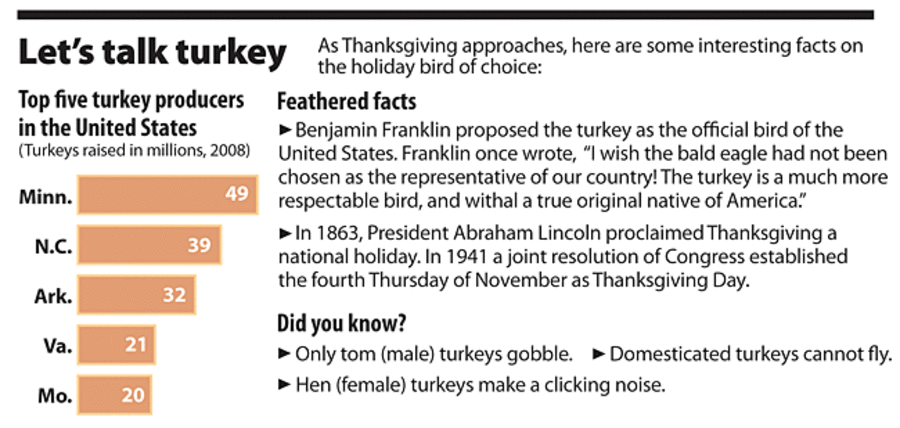Is lobster the new turkey for Thanksgiving?
Loading...
A New England woman mounts a campaign to buoy struggling local fishermen. An Oregon man, after several failed experiments, crafts a dish to bring a marginalized minority back to holiday dinner tables. New Orleans chefs splash a staid occasion with Southern flavor.
All of them share the same goal: to steal some of the Thanksgiving limelight from Tom Turkey.
No one will knock the beloved bird from its place in America's most traditional holiday. Some 88 percent of Americans ate turkey last Thanksgiving, according to the National Turkey Federation. But rivals are trying to chip away at the gobbler's lead.
This year's most direct challenge comes from Julia Munsey of Bangor, Maine, who worries about the state's lobster industry. The global financial crisis has depressed demand from Canada as well as the US, sending prices to lows not seen since the 1980s. This year's high fuel prices squeezed lobstermen even more.
"I kept thinking, 'I wish there was something I could do to help,' " Ms. Munsey says. "At the very least, I could buy lobster."
So she served lobster at her birthday dinner last month, hoping to inspire fellow residents to do the same by getting local media to cover the event. That gave rise to a grander idea: the Thanksgiving lobster.
Granted, the tasty crustacean is far pricier than turkey and it might seem slightly off-putting to the gravy-and-cranberry-sauce set. But it's quicker to prepare and, for those who relish real tradition, historical documents suggest it may well have graced the Pilgrims' first Thanksgiving table. (It's mentioned along with wild turkey as a staple of Plymouth's autumn diet.)
Munsey approached friends at a marketing firm, who agreed to work pro bono on promoting the idea nationally. Two key state lawmakers lent their support at a news conference Nov. 18. That unleashed a flood of promises from residents to trade in the juicy bird – or, in the case of Thanksgiving purists, a side dish or two – for the area's signature seafood come Thursday.
"We would love to have people choose lobster instead of turkey. That would really make an impact in the industry," Munsey says. "But we understand that traditions are traditions."
Rigid holiday protocol actually helped Seth Tibbott craft his Thanksgiving alternative. For years, vegetarians faced a common dilemma: either munch only on salads and sides or force turkey-dinner hosts to scramble for another option.
Mr. Tibbott tried a gluten roast – which diners "couldn't cut with a chain saw," he recalls – and a stuffed pumpkin without enough heft for a main dish. Finally, his company birthed the tofu-based turkey substitute Tofurkey.
Even in turkey's long shadow, it worked. After selling 500 of them that first year – 1995 – sales have soared. This year, Tibbott's Turtle Island Foods in Hood River, Ore., expects to clear 300,000 Tofurkeys between October and December. Tofurkey now stands as a major player in the meat-alternative industry, whose sales – not counting leaders like national chain Whole Foods, which doesn't provide any data – exceeded $586 million during the past 12 months and grew by 8 percent compared with the year before.
Real meat is another potential competitor. Retailers have long promoted prime rib and boneless roasts over the holidays, says Meghan Pusey of the National Cattlemen's Beef Association. In recent years, the association has tried to help stores see the value in cheaper cuts. This year, more roasts from the chuck and round are on the shelves.
The number of stores featuring Cornish game hens reached 4,300 this week – a record in the four years that the US Department of Agriculture has been tracking the trend.
The hens, as well as bagged chickens for roasting, receive "significant seasonal interest," says Richard Lobb of the National Chicken Council. "It's certainly an overlooked trend."
Another boost for the nonturkey crowd: Immigrants, notably the growing number of Asians, often substitute native dishes for turkey as families gather on Thanksgiving.
Lobster, sliced beef, and lamb are currently among the biggest sellers at CMart, an ethnic supermarket in Boston.
"We don't even have turkey," says Alvin Qu, a CMart employee. "Chinese people don't buy turkey. They don't know how to cook it."
Restaurants represent another arena for antiturkey diners to vote with their menu selections. Some 11 percent of Americans now eat out on Thanksgiving day, according to the National Restaurant Association.
When they come to upscale Café Adelaide in New Orleans, about half the patrons order the venue's jazzy Southern take on turkey, stuffed with herb butter and truffle oil, says Orlando Harris, a sous chef. Those who don't typically seek something else, maybe quail or goose, accompanied by ray beans and ricotta greens, or stuffed flounder.
Yet even away from the classic family feast, "Turkey's still the winner," Mr. Harris says.





